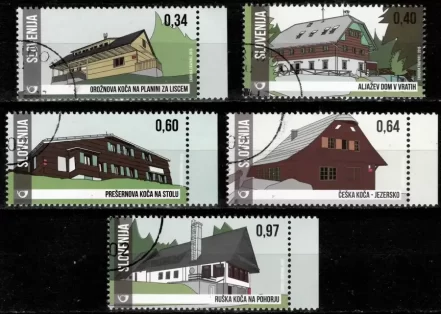Slovenia year 2015 stamps Architecture – Mountain Huts Used set
in 2015, Slovenia (Pošta Slovenije) issued a set of stamps in the Architecture category dedicated to Mountain Huts (Planinske koče)—a vital part of Slovenian alpine culture.
This was a relatively large set designed to celebrate the history and architecture of these refuges.
⛰️ Slovenia 2015 Architecture – Mountain Huts Set
The issue consists of five different stamps, released on May 29, 2015. The set showcases different examples of these historic structures located in Slovenia’s high mountains.
| Denomination | Michel Catalog No. | Theme/Image Description (Examples) |
| 0.34 € | 1147 | Represents one of the smaller, older huts. |
| 0.40 € | 1148 | Features a mid-sized, perhaps more traditional hut. |
| 0.60 € | 1149 | Highlights a key hut, such as a major PZS (Alpine Association of Slovenia) facility. |
| 0.64 € | 1150 | Showcases a specific famous hut known for its location or architecture. |
| 0.97 € | 1151 | Features the highest value stamp, likely depicting a landmark hut high in the Julian or Kamnik-Savinja Alps. |
Series Details
- Date of Issue: May 29, 2015
- Set Size: 5 stamps
- Theme: The stamps honor the Slovenian Mountain Huts that provide shelter and rest for hikers and mountaineers on the country’s extensive network of mountain trails.
- Catalog Codes: The set is typically listed in the Michel catalog as 1147-1151.









